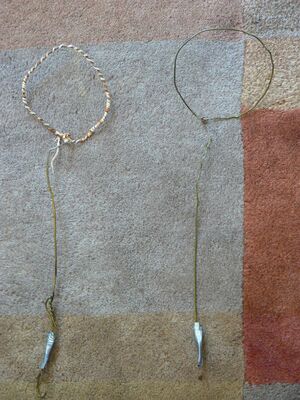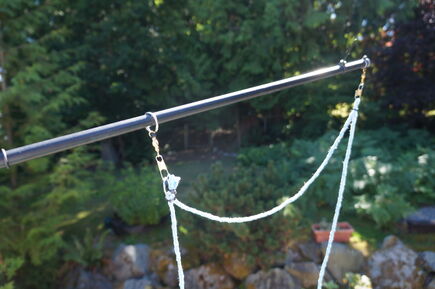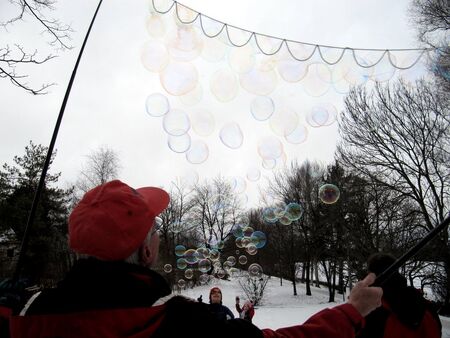m (Reverted edits by 204.122.255.227 (talk | block) to last version by Espiegel123) |
|||
| (24 intermediate revisions by 8 users not shown) | |||
| Line 1: | Line 1: | ||
| + | {{InfoGeneral}} |
||
| − | + | Bubble wands come in a large variety of shapes and sizes and may not be wand-like at all. A variety of common household materials can be used to create bubbles from tiny to whale-size. Making your own wands can be edifying and a great project for kids, parents or parents and kids together. |
|
Most people find that their homemade wands work better than manufactured wands -- and they are considerably less expensive. You can make a [[Wands#Tri-string wands|tri-string wand]] wand suitable for creating 20 to 30 foot long bubbles tubes for only a few dollars -- less if you have the materials on hand. |
Most people find that their homemade wands work better than manufactured wands -- and they are considerably less expensive. You can make a [[Wands#Tri-string wands|tri-string wand]] wand suitable for creating 20 to 30 foot long bubbles tubes for only a few dollars -- less if you have the materials on hand. |
||
| + | |||
| + | The [[:Category:DIY|DIY]] and [[:Category:How-To|How-To]] categories have articles detailing some great Do-It-Yourself wands and bubble tools. |
||
==Types of Wands== |
==Types of Wands== |
||
Wands can be traditional plastic wands that come in bottles of commercial bubble solution but they can be made from just about anything -- even your [http://www.youtube.com/watch?v=mKxmqFI8Nk0 hands] can be used to blow bubbles (if they are wet). Great wands can be made from drinking straws, string, wire hangers, and even paper. Paper cones can be made to blow basketball-sized bubbles and bubble domes (as demonstrated in the videos below). |
Wands can be traditional plastic wands that come in bottles of commercial bubble solution but they can be made from just about anything -- even your [http://www.youtube.com/watch?v=mKxmqFI8Nk0 hands] can be used to blow bubbles (if they are wet). Great wands can be made from drinking straws, string, wire hangers, and even paper. Paper cones can be made to blow basketball-sized bubbles and bubble domes (as demonstrated in the videos below). |
||
| ⚫ | |||
| − | |||
| − | |||
| ⚫ | |||
P1030582 common.JPG|Some common cheap bubble toys that are often included in the purchase of a bottle of commercial bubble juice. |
P1030582 common.JPG|Some common cheap bubble toys that are often included in the purchase of a bottle of commercial bubble juice. |
||
P1030580 crop 24inchstring.jpg|A homemade tri-string wand made from cotton twine, two bamboo garden stakes, duct tape and a washer. |
P1030580 crop 24inchstring.jpg|A homemade tri-string wand made from cotton twine, two bamboo garden stakes, duct tape and a washer. |
||
P1030579 crop two wands.jpg|Two homemade tri-string wands (one with a 48-inch top string and the other with a 24 inch top string. |
P1030579 crop two wands.jpg|Two homemade tri-string wands (one with a 48-inch top string and the other with a 24 inch top string. |
||
| − | + | Bmi coathanger hoops CROP.jpg|Homemade wands made by bending a coathanger. They are wrapped with twine to help them hold lots of bubble juice. |
|
| + | KMJ NoDip Vers 1 documentation 2012.jpg|NoDip Wand: Bubble Solution feeds from pressurized container to establish a soap film and/or feed the growing bubble. |
||
| + | DSC06234.JPG|Ric Merry writes: "I call this a "snare wand". Not sure if there is another term. It's a single pole and the lower ring slides freely. It works well on windy days." EDITOR'S NOTE: This seems to be a DIY version of David Stein's wonderful Bubble Thing -- the invention that started the giant bubble sport. |
||
</gallery> |
</gallery> |
||
| Line 19: | Line 22: | ||
'''Paper Cones. '''The soccer ball size bubbles in the video below were created with paper cones like the ones documented at [http://www.zurqui.com/crinfocus/bubble/tube.html Bubble Town]. |
'''Paper Cones. '''The soccer ball size bubbles in the video below were created with paper cones like the ones documented at [http://www.zurqui.com/crinfocus/bubble/tube.html Bubble Town]. |
||
| − | {| align="center" border="0" cellpadding="1" cellspacing="1 |
+ | {| style="width: 260px;" align="center" border="0" cellpadding="1" cellspacing="1" |
| − | |[[ |
+ | |[[File:Bubble Domes Created with a Paper Cone|thumb|500px|right|These bubbles were created with a simple paper cone and solution that is ultra dawn, water and glycerine.]] |
|- |
|- |
||
| |
| |
||
| Line 33: | Line 36: | ||
[[File:P1030579_crop_two_wands.jpg|thumb|center|450px|Two homemade tri-string wands.]] |
[[File:P1030579_crop_two_wands.jpg|thumb|center|450px|Two homemade tri-string wands.]] |
||
| + | [[Tri-String_Wands|Tri-string wands]] are the most popular type of wand for making giant bubbles. A super simple (yet effective) one can be made from just a couple of sticks and some suitable string, yarn or material. Fancier tri-strings can be made with clips and swivels that optimize the bubble-making experience. |
||
| − | Tri-string wands (so-called because of the triangular appearance of the string) are a popular and easy-to-make wand that can be used to make bubbles from small to whale-size depending on the length of the string. Tri-string wands generally consist of a top-string tied (or otherwise connected) to a bottom-string that is roughly twice its length. The bottom-string is often threaded through a metal washer that weighs down the string slightly. The strings are then attached to poles or sticks. |
||
| + | They can be used to make bubbles from small to whale-size depending on the size of the loop. |
||
| − | Cotton twine works well for small and medium wands (I personally have used wands with top-strings from 8-inches to four-feet). Many materials are used from cotton shoelaces to simple twine to thin rope. There seems to be general agreement that natural fibers (such as cotton) work better than synthetics. Many bubblers search for the perfect "string" and even make their own rope (which is actually quite easy to do and which I hope to cover in another section of this Wiki). More is not necessarily better. For large wands, a single thickness of twine may not absorb enough bubble juice to create huge bubbles. I have found that a double-length of twine twisted or braided together works better than a single length for wands up to to 48 inches. Increasing twine thickness beyond that with wands of this size doesn't seem to improve the result (and may waste bubble juice). |
||
| + | '''Find out more'''. Read all about them in the article: [[Tri-String Wands]] |
||
| − | Many methods can be used to attach the strings to the poles. I just tied the strings tightly on my first wands. Some people attach the string directly to the poles/handles. Others prefer to attach a short string or light chain or hook to the pole/handles and attach the string to that. |
||
| ⚫ | |||
| − | Thommy has posted a great [[User blog:Thommy504/Some details on my wands|blog entry]] about string materials and how to attach them. |
||
| + | A ''Garland Wand'' or ''Bubble Garland'' is a variant of the tri-string design. It consists of two handles that are attached to a series of looplets. Find out more about [[Garland Wand|garland wands]]. |
||
| + | [[File:IMG_7410-1.jpg|thumb|center|450px|A garland wand in use]] |
||
| ⚫ | |||
| + | ==NoDip Wand/System== |
||
| ⚫ | |||
| + | The [[NoDip System]] is a simple and effective setup for feeding a soap solution & establish a soap film on a Tri-String (or other sort of) wand. ''NoDipping'' frees strolling bubblers from their buckets & much, much more. See the [[NoDip System]] page for more information including instructions on building your own. |
||
| + | [[File:KMJ_NoDip_Vers_1_documentation_2012.jpg|thumb|left|326px|Valve is in right hand.]]{{ClearFloat}} |
||
| − | <p style="text-align: center;">[[Video:An 18-inch tri-string wand in action|660px|An 18-inch tri-string wand in action]]</p> |
||
| + | ==Hoops == |
||
| + | Hoops from small to large are a popular bubble-making apparatus that can be purchased or made at home. See [[Hoops]]. |
||
| + | [[File:Brian_lawrence_Bubble_Hoops.jpg|thumb|left|300px|A selection of hoops made by Brian Lawrence that ranges from 5-inches to 40 inches(or more)]][[File:BILD0570_thommy_hoops.JPG|thumb|300px|A collection of handmade hoops and a plastic commercial hoop.]] |
||
| − | {{ |
+ | {{ClearFloat}} |
| ⚫ | |||
| − | To use a tri-string wand, you simply dip the string into a container of bubble juice, lift up the wand with the handles held together, spread the handles apart to let the bubble start forming (you may have to walk forwards or backwards if there is no breeze) and then bring the handles back together to close the bubble as in the video. |
||
| ⚫ | Hoops can be easily fashioned from hanger wire in a variety of shapes and sizes. Clothes-hanger wire is a great material for making wands as you can bend it into a large variety of shapes and sizes. Simply unravel the hanger. Bend one end of the wire to make some sort of closed shape. Bend the handle with an angle convenient for dipping into a tray. You can use a pie tin as a dip tray. Lastly, wrap the looped part of the wand with cotton twine or cotton yarn. The string/yarn makes it much easier to make bubbles with this type of wand than if you leave the wire bare. Aluminum rods can also be used; aluminum rod is inexpensive, strong, easy to work with and can often be found at the local hardware or home improvement store. |
||
| + | See the [[:Category:Hoops|Hoops]] category index for more ideas and fun projects. |
||
| − | See more videos in the section [[Giant Bubbles]] |
||
| + | [[File:BILD0570_thommy_hoops.JPG|thumb|300px|A collection of handmade hoops and a plastic commercial hoop.]][[File:P1030581_two_wire_hoops.JPG|thumb|left|300px]] |
||
| − | |||
| − | ===Tips for Using Tri-String Wands=== |
||
| − | *If there is a lot of wind, don't open the string all the way open and stand so that the opening is at a 30 degree to 45 degree angle with the wind. |
||
| − | *If there is no wind, open the wand and walk backwards to create the bubble. |
||
| − | *If there is a lot of wind, walk forward as the bubble forms to keep rapid expansion from bursting the bubble. |
||
| − | *Since conditions radically impact the size of bubbles that can be made, start your bubbling sessions by making several bubbles that you let grow until they burst so that you get an idea of how large a bubble the conditions (and your bubble juice) will allow. Thereafter, you can let your bubbles grow until they are a bit smaller than the bursting size and close them off. |
||
| − | *It is often useful to have the poles raised above you so that your body doesn't become a source of eddies and vortices that make it tricky to close a bubble off. |
||
| − | *Long poles held high can help you launch the bubbles far enough off the ground that they don't quickly sink to the ground and pop. Launching high also increases the chances that the bubble will be caught by an updraft that will carry the bubble up. |
||
| − | See also [[Rigging_Loops_for_Tri-String_Wands|Rigging Loops for Tri-String_Wands]] |
||
| − | |||
| − | ===How To Make a Tri-String Wand=== |
||
| − | |||
| − | Tri-string wands can be extremely primitive or elegant. Even the most primitive wand can create beautiful bubbles and tubes. Here are step-by-step instructions for a really primitive wand (which will work nicely). |
||
| − | |||
| − | [[File:P1030580_crop_24inchstring.jpg|center|450px|A primitive tri-string wand]] |
||
| − | |||
| − | '''What you need'''. Two handles/poles. Some cotton twine. Optional: a metal washer or nut. |
||
| − | |||
| − | '''Your poles/handles''' can be anything from chopsticks (for a small wand) to bamboo garden stakes to dowels to .... well just about anything. For small wands, bamboo garden stakes are handy -- they are cheap and light. The wand shown in the picture uses bamboo garden stakes. '''For the string''', you can use simple cotton twine or butcher's string or something heavier. Cotton (but not polyester) shoelaces work okay. For a big wand, you could use cotton clothesline although I find a couple of strands of twisted twine to be sufficient when you have a wand where the top=string is in the 36 to 48-inch range. For smaller wands, a single strand of twine works just fine (it does for bigger wands, too but they will benefit from another strand or two). '''A metal washer or nut''' can be handy but isn't necessary. Some purists don't believe in them but beginners will find them useful for keeping the string straight and making dipping into the container easier. |
||
| − | |||
| − | #Decide how big you want your wand to be. The "loop" is going to be made from two lengths of string: the top-string and the bottom-string. My first wand had an 18-inch top string -- and we had loads of fun with it. You can create bubbles up to about twice the diameter of the top string . For a first wand, it is recommended that you start with a top-string 18 to 24 inches long. |
||
| − | #Cut two lengths of string: a top-string and a bottom-string that is twice the top-strings length. |
||
| − | #(Optional) Thread the longer string through the washer . |
||
| − | #Tie the two strings together at both ends to make a loop. |
||
| − | #Connect the loop to your handles/poles. There are many ways to connect the loop to your handles. For my first wand, I cut two pieces of string a few inches long and tied one end tightly to the pole and the other end to place where the top string and bottom-string met. For later wands, I tied a short string to each pole and tied a fishing swivel on the other and so that I can clip and unclip wand loops from the poles which makes swapping loops easy. |
||
| − | |||
| − | There are much more elegant designs that people have but this should get you started. |
||
| − | |||
| − | ===Long Handles for Tri-String Wands=== |
||
| − | For loops that have a top-string of 60-inches or less, 48-inch wooden dowels, bamboo gardening stakes and lengths of 1/2-inch PVC tubing are inexpensive easily available materials. Some people like to have extra long handle on-hand. These are useful both for using large loops and for keeping normal-sized loops high above the ground -- which gives the bubbles more time before hitting the ground and may give an opportunity to get some loft. |
||
| − | |||
| − | Lightweight telescoping fishing rods are popular among giant bubble enthusiasts. The "[http://www.cabelas.com/product/Cabelas-Classic-Crappie-Pole/738689.uts Classic Crappie Pole]" from Cabelas.com is a popular choice. Some people remove the thinnest section(s) of the poles because they may be a bit too flimsy for a large loop heavy with bubble juice. The 13-foot Cabela's pole is about 10 feet long when the two flimsiest sections are removed. There is general consensus that poles longer than 10 to 12 feet are quite unwieldy. Another popular choice for long handles is the '''Shakespeare Wonder Pole'''. The 10-foot model as been recommended by more than one well-respected enthusiast. '''Kwik Stix''' by South Bend is another popular telescoping fishing pole that can be found inexpensively. |
||
| − | |||
| − | It is also possible to create 96-inch (or longer) handles that can be broken down into smaller sections using wooden dowels and appropriate fittings as detailed in the [[Pole_Extensions|Pole Extensions article]] . |
||
[[Category:Poles]] |
[[Category:Poles]] |
||
| − | |||
| − | ===Large Tri-String Loops=== |
||
| − | It is often noted by people that explore using very large loops that 10-foot loops generally don't create bubbles that are significantly larger than 5 or 6-foot loops -- and they are much more difficult to manage. However, under the right conditions with the right bubble juice and the right loop material, it is possible to create tall bubbles with large loops that can be quite impressive. It seems that very large loops may require different bubble juice and different loop materials than smaller setups to reach their maximum potential. Very large loops also require calm conditions were the soap film won't encounter too many particles. |
||
| − | |||
| − | See also [[Rigging_Loops_for_Tri-String_Wands|Rigging Loops for Tri-String_Wands]] |
||
| − | |||
| − | ===Custom Cords/Ropes for Tri-String Wands=== |
||
| − | Most people that get serious about big bubbles, eventually seek out the ideal material to use for the string. Everything from butcher's twine to upholstery piping and mop yarn and clotheslines have been tried. Making custom rope/cord is trivially easy and has many rewards as they generally work better than off-the-shelf cord, rope or yarn. Read more on this topic in the article [[Rope and Cord Making]] which includes step-by-step instructions and video. |
||
| − | |||
| ⚫ | |||
| − | <p style="text-align: center;">[[File:IMG_7410-1.jpg|thumb|center|450px|A garland wand in use]] Garland Wands are a variation of the tri-string design. More about [[:Category:Garland|Garland]] wands.</p> |
||
| − | |||
| − | {{Template:ClearFloat}} |
||
| − | |||
| ⚫ | |||
| ⚫ | Clothes-hanger wire is a great material for making wands as you can bend it into a large variety of shapes and sizes. Simply unravel the hanger. Bend one end of the wire to make some sort of closed shape. Bend the handle with an angle convenient for dipping into a tray. You can use a pie tin as a dip tray. Lastly, wrap the looped part of the wand with cotton twine or cotton yarn. The string/yarn makes it much easier to make bubbles with this type of wand than if you leave the wire bare. |
||
| − | |||
| − | [[File:P1030581_two_wire_hoops.JPG|thumb|center|300px]] |
||
[[Category:Garland]] |
[[Category:Garland]] |
||
[[Category:Tri-String]] |
[[Category:Tri-String]] |
||
[[Category:General]] |
[[Category:General]] |
||
[[Category:Wands]] |
[[Category:Wands]] |
||
| + | [[Category:NoDip]] |
||
| + | [[Category:For Index]] |
||
Latest revision as of 14:16, 11 May 2017
| Popular Pages | |
|---|---|
|
Getting Started |
|
|
Getting Deeper |
Ingredients,Test Matrix,Controversies,Questions,E's Bubble Blog |
|
Contact |
|
Bubble wands come in a large variety of shapes and sizes and may not be wand-like at all. A variety of common household materials can be used to create bubbles from tiny to whale-size. Making your own wands can be edifying and a great project for kids, parents or parents and kids together.
Most people find that their homemade wands work better than manufactured wands -- and they are considerably less expensive. You can make a tri-string wand wand suitable for creating 20 to 30 foot long bubbles tubes for only a few dollars -- less if you have the materials on hand.
The DIY and How-To categories have articles detailing some great Do-It-Yourself wands and bubble tools.
Types of Wands[]
Wands can be traditional plastic wands that come in bottles of commercial bubble solution but they can be made from just about anything -- even your hands can be used to blow bubbles (if they are wet). Great wands can be made from drinking straws, string, wire hangers, and even paper. Paper cones can be made to blow basketball-sized bubbles and bubble domes (as demonstrated in the videos below).
Paper Cones. The soccer ball size bubbles in the video below were created with paper cones like the ones documented at Bubble Town.
 Bubble Domes Created with a Paper Cone These bubbles were created with a simple paper cone and solution that is ultra dawn, water and glycerine. |
[MORE INFO AND PICTURES NEEDED] Please help this page grow -- and add pictures of your favorite wands!
Tri-String[]
Tri-string wands are the most popular type of wand for making giant bubbles. A super simple (yet effective) one can be made from just a couple of sticks and some suitable string, yarn or material. Fancier tri-strings can be made with clips and swivels that optimize the bubble-making experience.
They can be used to make bubbles from small to whale-size depending on the size of the loop.
Find out more. Read all about them in the article: Tri-String Wands
Garland Wand[]
A Garland Wand or Bubble Garland is a variant of the tri-string design. It consists of two handles that are attached to a series of looplets. Find out more about garland wands.
NoDip Wand/System[]
The NoDip System is a simple and effective setup for feeding a soap solution & establish a soap film on a Tri-String (or other sort of) wand. NoDipping frees strolling bubblers from their buckets & much, much more. See the NoDip System page for more information including instructions on building your own.
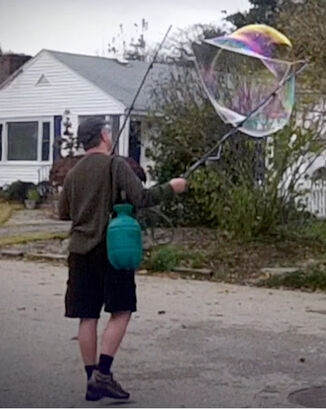
Valve is in right hand.
Hoops[]
Hoops from small to large are a popular bubble-making apparatus that can be purchased or made at home. See Hoops.
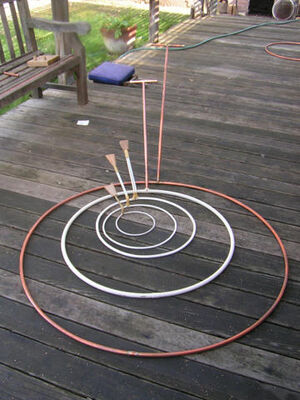
A selection of hoops made by Brian Lawrence that ranges from 5-inches to 40 inches(or more)
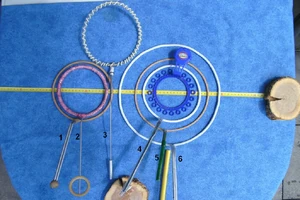
A collection of handmade hoops and a plastic commercial hoop.
Wire Wands[]
Hoops can be easily fashioned from hanger wire in a variety of shapes and sizes. Clothes-hanger wire is a great material for making wands as you can bend it into a large variety of shapes and sizes. Simply unravel the hanger. Bend one end of the wire to make some sort of closed shape. Bend the handle with an angle convenient for dipping into a tray. You can use a pie tin as a dip tray. Lastly, wrap the looped part of the wand with cotton twine or cotton yarn. The string/yarn makes it much easier to make bubbles with this type of wand than if you leave the wire bare. Aluminum rods can also be used; aluminum rod is inexpensive, strong, easy to work with and can often be found at the local hardware or home improvement store.
See the Hoops category index for more ideas and fun projects.

A collection of handmade hoops and a plastic commercial hoop.
